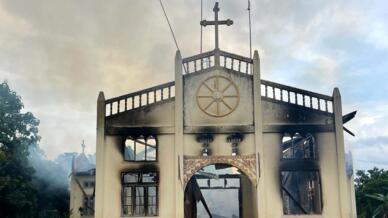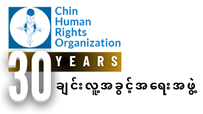Burned churches: Myanmar’s junta accused of abuses against the Christian minority (france24.com)
Burned churches: Myanmar’s junta accused of abuses against the Christian minority

Since coming to power in a 2021 coup, the Mynamar military junta has been accused of abuses against the Christian minority, which represents 6% of the country’s population. Local NGOs have condemned the destruction of Christian places of worship.
>> Read on The Observers: How rebel fighters are using 3D-printed arms to fight the Myanmar junta
Images circulating on social networks show churches with smoke-blackened or destroyed walls, debris on the ground, and damaged bibles and other religious symbols.

Geolocation here

The church was in perfect condition in 2018, as this geolocation on google maps shows.
Near the town of Demoso, in Kayah State, all that remains of St Matthew’s Church is a burned-out facade, after the Myanmar army raided it on 15 June 2022. David Eubank, a former Texas soldier and fervent Christian who founded the humanitarian aid association “Free Burma Rangers“, was in Demoso when the clashes between the army and resistance fighters broke out. He told us: “The army was shooting at us, it was hard to see anything. I heard several ‘booms’ and then the church caught fire. Before they left, they [the military] left several anti-personnel mines around the church. A 16-year-old Burmese boy stepped on them, luckily we were able to save him.”
The St Matthew’s churchgoers live in the jungle, like many Karenni villagers (ethnic group in Kayah State), and pray every Sunday in a makeshift church-school made of leaves and plastic.
>> Read on The Observers:
>> À LIRE SUR LES OBSERVATEURS: Residents of Myanmar’s Kayah State flee to jungle to escape military junta
Several churches have been destroyed in Kayah State villages, where the army has been conducting regular air strikes and ground operations in an attempt to quell resistance from Karenni rebels. David Eubanks told us about several attacks on Christian churches that he and his teams have witnessed.


The state of Chin, located on the Indian border in the west of the country, has also been the scene of clashes between the army and resistance movements. More than 80 percent of the state is Christian.
“The church I went to as a child has been destroyed”
Salai Za Uk Ling is Deputy Executive Director the Chin State Human Rights Organisation (CHRO). He is a Baptist Christian m and along with his team, Salai Za Uk Ling documents abuses committed by the country’s army. They have counted more than 50 church attacks since February 2021 in Chin State, which range from aerial bombardments to ransacking by ground troops.
In churches, the army destroys everything and takes away valuables, including offerings and collection money. This destruction of churches usually occurs when the army moves in convoy through villages.
I was born and raised in Thantlang and the whole town has been attacked more than 30 times, since September 2021. The church I went to as a child was destroyed. The army maintains a presence there and it is dangerous to go back.
Dans la ville de Thantlang, ouest de l’État de Chin, onze églises ont été prises pour cible par la junte selon la Chin Human Rights Organization (CHRO).
In September 2021, the pastor of a Baptist church in Thantlang was shot by the army while trying to save his burning church after a bombing. His phone book was cut off and his wedding ring stolen, according to the Chin Human Rights Organization (CHRO).

Géolocalisation ici
Salai Za Uk Ling added:
[In Chin State], the junta is targeting churches, hospitals and schools… We know from testimonies of former army personnel that the military is instructed to ‘clear anything that might be in their way’. Much of the fighting between the junta and the resistance is taking place where Christian ethnic groups live (Chin, Karen and Kayah states), so many churches and infrastructures have been affected.
On 24 December 2021, Christmas Eve, the army massacred 35 people in a Christian village in Kayah State.
The junta spokesman said that places of worship were not targeted, except during raids, when it had information that “terrorists” (rebels) were hiding inside. Our observer, as well as many other witnesses, have disputed this statement.
When the military arrives in a village, they use churches as a base, because they know that Christians from the resistance forces will not attack them in the church.
Analysts from Myanmar Witness, a project that documents human rights abuses in the country, told the Observers that it is difficult to know whether the churches are being targeted by the Myanmar military on purpose, or whether they are collateral damage from clashes with resistance movements.
“Anything that is not Buddhist can be considered suspicious”
Salai Za Uk Ling has been documenting human rights abuses in Chin State for 27 years, and according to him, this kind of discrimination is nothing new.
Discrimination on the basis of Christian identity has always been a problem for the Chin [and other Christian ethnicities], as has the destruction of Christian buildings. This is a way for them [the army] to physically destroy Christianity. The junta already removed several large crosses from hilltops in the past (the junta was already in power before Aung San Suu Kyi’s party came to power in democratic elections in 2015: Editor’s note). Several religious buildings were also destroyed under previous regimes.
Anything that is not Buddhist can be viewed as suspicious. The Buddhist majority has always been valued, there is a very nationalistic view of religion.
The various ethnic and religious minorities in Myanmar have long been discriminated against by successive Buddhist regimes. Foremost among these is the Rohingya Muslim minority, made stateless by a 1982 law and considered one of the most persecuted minorities in the world. Since the military coup, the army has also been accused of occupying and burning mosques.
In June, Pope Francis and Myanmar’s Christian religious leaders called on the junta to stop attacking religious buildings.
The Myanmar army is predominantly Buddhist, and has pledged to protect Buddhism, which for our Observers may explain why they have no qualms about attacking churches. The army has also been accused of destroying around 100 Buddhist monasteries.
1,900 civilians have been murdered by junta soldiers since February 2021, according to a statement by UN Human Rights Council High Commissioner Michelle Bachelet, in which she referred to “war crimes” and “crimes against humanity” perpetrated by Myanmar’s military.
